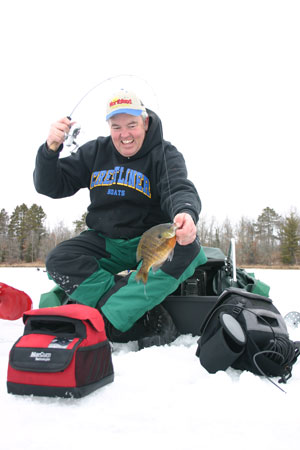Itís time to get back on the ice and get after a few walleyes, maybe a bunch of fast action perch, or even some big slab crappies or hefty
bull bluegills. Whatever the case; let the good times roll. However,
before you grab your gear and go charging out to make history, it might
be a good idea to take a little time and make sure youíre prepared.
There are some basic items besides the obvious that you really couldnít
get by without, and if overlooked or forgotten your first trip might not
be what it could have been. To help with your preparation a pre-ice mock
up is in order, and includes laying out all of your equipment and then
thinking through a full day and what you might end up needing.
a bunch of fast action perch, or even some big slab crappies or hefty
bull bluegills. Whatever the case; let the good times roll. However,
before you grab your gear and go charging out to make history, it might
be a good idea to take a little time and make sure youíre prepared.
There are some basic items besides the obvious that you really couldnít
get by without, and if overlooked or forgotten your first trip might not
be what it could have been. To help with your preparation a pre-ice mock
up is in order, and includes laying out all of your equipment and then
thinking through a full day and what you might end up needing.
If youíre going to be using a portable shelter; set
it up and make sure everything is there including a tow rope, especially
if you plan on walking out. Doesnít sound like a big deal but it
definitely could be if you really need it.
Whether youíre walking out or not, a good pair of
ice cleats is an item that often gets overlooked and really is a safety
issue. Many times Iíve seen anglers with their feet up level with their
eyes just before they slam down hard on the ice. Cleats could have
saved them the trouble and the pain and what could easily result in a
serious injury. The best cleats are easy to put on and provide traction
on the heel and ball of the foot. Anything less and sooner or later
youíre going to be kissing the ice.
Another item related to safety is a pair of ice
picks designed to help you pull yourself back up on the ice if you
happen to go in. Itís not something most want to think about but
really should prepare for in case the worst were to happen. A set of
picks could save your life and are well worth the money. They donít
takeup much room and easily fit in a coat pocket. Team Crestliner
member Danny Plautz of Muskego, Wisconsin also brings along a fifty-foot
length of rope: ďAt first ice I never go alone and always bring along
the rope in case somebody falls through. Iíll tie some knots in one end
to make it easier to throw.Ē
Although early ice may mean moderate temperatures,
a good heater is still a must. Even if it worked last year before you
put it away for the season it wouldnít hurt to fire it up now, just to
be sure. During the off-season things happen, whether itís rust, or
maybe just an insect thatís make a cocoon in the wrong place. The thing
is it doesnít take that long to make sure itís in working order.
Getting the heater lit is another component to your
fist ice checklist. Matches can get the job done but need to be kept
dry. A waterproof container like the ones designed for camping are the
ticket and well worth a couple dollar investment. Another good option
is a butane lighter, like the typed used for starting charcoal. They
help to keep your hands away from the flame and eliminate the smell of
burnt hair. Even if you have a lighter matches in a waterproof
container are still a good backup, just in case.
As you run the first trip through your mind youíll
get to the point where you have to drill some holes. You can probably
get by with a hand auger at first ice, as long as the blades are sharp.
To be sure; trydragging your thumbnail against the blade and see if it
starts to shave a little off. If it wonít, or doesnít digin, you better
have them sharpened or replaced. If you plan on using a gas auger
check the blades and tryfiring it up to make sure itís in good running
order. It wouldnít hurt to have a chisel along as well, to help test
questionable ice and to bust loose a shelter that might have frozen
down.
If youíll be using an electronic depth finder it
would be advisable to make sure the battery is still good and fully
charged. My Marcum LX-5 has an LCD charge indicator that letís me see
at a glance just exactly how much juice I have left. After charging
your unit, fire it up and make sure itís operational. A depth finder
is the most important piece of fishing equipment that I can bring with
and if itís not running Iím out of business and probably headed home.
Another depth finder that Iíll use is the Marcum
LX-i which is a handheld thatís mainly used for finding structure. Itís
a handy tool that has a transducer built into the face and is read by
pouring a little water on the ice and then pushing it tight. Thereís a
digital readout on the top that will first show the bottom depth and
then flash the depth of anything holding up off the bottom. Instead of
pouring water Iíll bring a self lighting torch along and melt some ice.
Itís quicker and easier than dragging water around and comes in handy
for lighting the aforementioned heater.
Sunglasses are another item related to safety as
you can easily burn your eyes under a bright sun. Besides the direct
sunlight thereís also reflected that light that compounds the problem
and you could end up with a painful case of welderís eyeís, if youíre
not careful. Along with the sunglasses you should also bring along
some sunscreen. If you havenít been burnt on the ice sooner or later
you will, if youíre not screened up.
Most trips are going to include some type of live
bait, heavy on the minnows. Getting bait to your intended destination
alive can be very important. Bait containers like the cheap Styrofoam
jobs are prone to tipping over and are not very durable. A better
option would be a smaller plastic insulated cooler with a nice square
base and a lid that locks securely in place. Another option would be
using a water jug with a lid that actually screws on. They can be laid
on their sides without losing any water and will hold quite a few
minnows. They also come in handy if you need to poor a little water on
the ice to read a depth finder. To get your minnows out of the bucket,
donít forget a net. Dipping your hands into ice-cold water to grab a
fresh minnow gets old fast.
Another handy item is a dry towel. When youíre
handling a lot of fish youíre hands can get cold and wet quickly. A
simple towel can keep you dry and keep you fishing a lot longer.
Surely thereís more to think about and everything
hasnít been covered here but this should help get you started. And if
thereís something that may have otherwise been forgotten thatís all the
better. See you on the ice.


 a bunch of fast action perch, or even some big slab crappies or hefty
bull bluegills. Whatever the case; let the good times roll. However,
before you grab your gear and go charging out to make history, it might
be a good idea to take a little time and make sure youíre prepared.
There are some basic items besides the obvious that you really couldnít
get by without, and if overlooked or forgotten your first trip might not
be what it could have been. To help with your preparation a pre-ice mock
up is in order, and includes laying out all of your equipment and then
thinking through a full day and what you might end up needing.
a bunch of fast action perch, or even some big slab crappies or hefty
bull bluegills. Whatever the case; let the good times roll. However,
before you grab your gear and go charging out to make history, it might
be a good idea to take a little time and make sure youíre prepared.
There are some basic items besides the obvious that you really couldnít
get by without, and if overlooked or forgotten your first trip might not
be what it could have been. To help with your preparation a pre-ice mock
up is in order, and includes laying out all of your equipment and then
thinking through a full day and what you might end up needing.